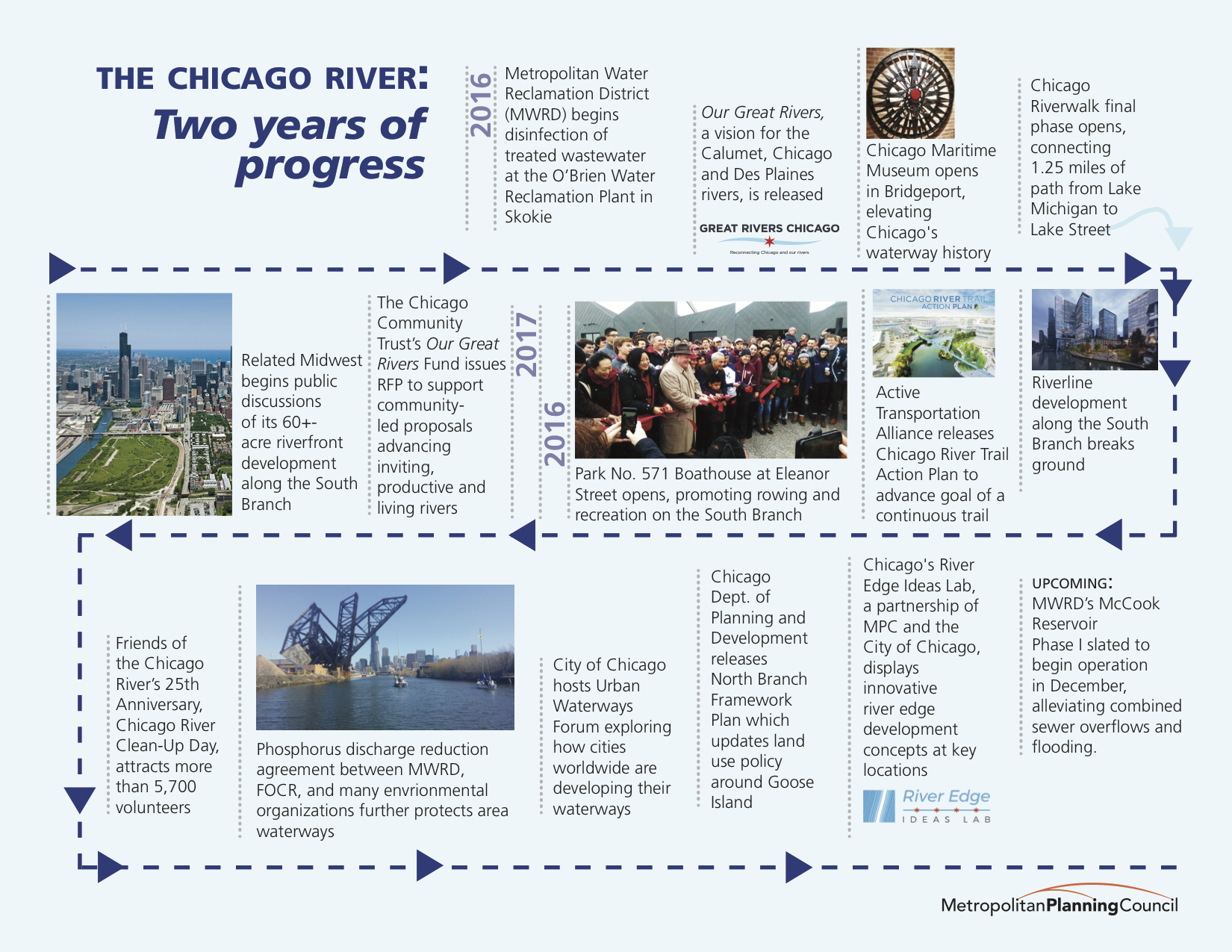A look back at significant progress along our rivers…with an eye to 2040
It’s been one year since the release of Our Great Rivers in August 2016, a unifying and forward-looking vision for the Chicago, Calumet and Des Plaines Rivers. Inviting, productive, living: These are the central pillars to that vision. We hope that by 2040, Chicago’s rivers will provide everyone with opportunities to find or create their own places, their own experiences and their own communities on our rivers.
During the year we worked on Great Rivers Chicago, and the year since its release, our rivers have witnessed tremendous progress to engage and reconnect us to this 150+ mile system of opportunities. It’s a signal of our collective willingness and leadership advancing the very aspirations of Our Great Rivers in tangible ways.
What better time to take stock of the progress along our rivers and highlight just a handful of the efforts that are creating new destinations, new experiences and a sense of community pride for our waterways.
Snapshot of river system improvements

2015
Chicagoans are getting closer to a continuous riverfront trail when the Cal-Sag Trail opened in 2015. Stretching for 13 miles from Alsip to Lemont, the trail connects people to the Cal-Sag Channel and the Calumet River system, various communities and a wider trail network emerging in Chicago’s southern stretches.
The Chicago River also hit a milestone in continuous riverfront trail progress. Phase 2 of the Chicago Riverwalk opened in 2015 between State Street and LaSalle (and was further extended in 2016 to connect 1.25 miles of path from Lake Michigan to Lake Street). In addition, Friends of the Chicago River successfully opened fish hotels along The Jetty segment of the Riverwalk to provide fish habitat right in the heart of downtown.
2015 was also a great year for river water quality, as my colleague Josh Ellis recaps in this blog post. The Metropolitan Water Reclamation District completed the Thornton Reservoir. It serves the South Side of Chicago and many south suburbs in Cook County. Since 2015, it has significantly reduced the combined sewer overflow events in the entire Calumet River System, which I expound on in this blog post.
Along the South Branch of the Chicago River, Related Midwest announced its 60+-acre new riverfront development that anticipates new residential, retail and employment options as well as riverfront access.
2016
New river-related events attracted people and investment to the rivers in 2016. The 1st Annual Cal-Sag Plunge took place along the Cal-Sag Channel as a fundraiser for the Cal-Sag Trail and to demonstrate improvements to the channel’s water quality. The 1st Annual Chicago Southland Dragon Boat Festival included music, vendors and yes, dragon boat racing on the Cal-Sag Channel, building team unity, community pride and friendly competition.
Active Transportation Alliance released its Chicago River Trail Action Plan in 2016 as a first major step to advance the broader goal of a continuous riverfront trail planning along the entire Chicago River.
In 2016, Riverline development broke ground as a new riverfront investment with plans for public access to the river. The Park No. 571 Boathouse at Eleanor Street also opened in 2016 promoting rowing and recreation on the South Branch of the Chicago River.
2017
A new funding source for all three of Chicago’s rivers became available in 2017. The Chicago Community Trust’s Our Great Rivers Fund issued a Request for Proposals to support community-led proposals advancing inviting, productive and living rivers, with awards being announced in September. 2017 also marked the five-year anniversary of the Chi-Cal Rivers Fund, which since 2013 has awarded 22 projects that have received a total of $4.8 million in grants to increase stormwater management, enhance habitat and improve public-use opportunities along the Chicago and Calumet river systems, among other drainage areas.
In 2017, MPC hosted two sold-out workshops to help community organizations and residents bring their riverfront activation ideas into a reality by navigating funding opportunities to the do’s and don’ts of placemaking.
Chicago’s Department of Planning and Development released its North Branch Framework Plan in 2017, the first framework developed as part of Mayor Emanuel’s Industrial Corridor Modernization Initiative. The plan updates land use policy along the Chicago River between Kinzie Street and Fullerton, and sets forth key recommendations for publicly accessible open space, riverfront trails, wetland parks and recreational spaces along the river.
Among the river-related recreational and stewardship events in 2017 was the 60th Des Plaines River Canoe and Kayak Marathon along 18.5 miles on the upper Des Plaines River, the second oldest continual canoe race in the United States. Downstream, more than 5,000 volunteers participated in Friends of the Chicago River’s 25th Anniversary Chicago River Clean-Up Day. The Calumet Waterway Stewards also held another successful annual stewardship clean-up and educational day on the Little Calumet River.
Entering the final months of 2017, the momentum along our rivers is charging full speed ahead. Chicago’s River Edge Ideas Lab, a partnership of MPC and the City of Chicago, displays innovative river edge development concepts at key locations. Check out the interactive exhibit at Expo 72 as well as traveling exhibits at various locations and neighborhoods throughout the city as part of the 2017 Chicago Architecture Biennial programming.
By December, the Metropolitan Water Reclamation District’s McCook Reservoir Phase I is slated as a major infrastructure investment soon to begin operation serving various Chicago waterways, including the Chicago River system, and is expected to substantially decrease combined sewer overflow events and flooding.
It takes a village…excited to forge ahead to 2040
These few examples represent a much larger scope of attention, investment and improvements we are experiencing all along Chicago’s three rivers.
This progress wouldn’t be possible if not for the enormous effort and leadership of the City of Chicago Mayor’s Office, Friends of the Chicago River, the Great Rivers Chicago Implementation Committee, MWRD and so many others forging a bright future for our rivers.
The road to 2040 and fully inviting, productive and living rivers is still a long one, but today, we have much to acknowledge and celebrate.
